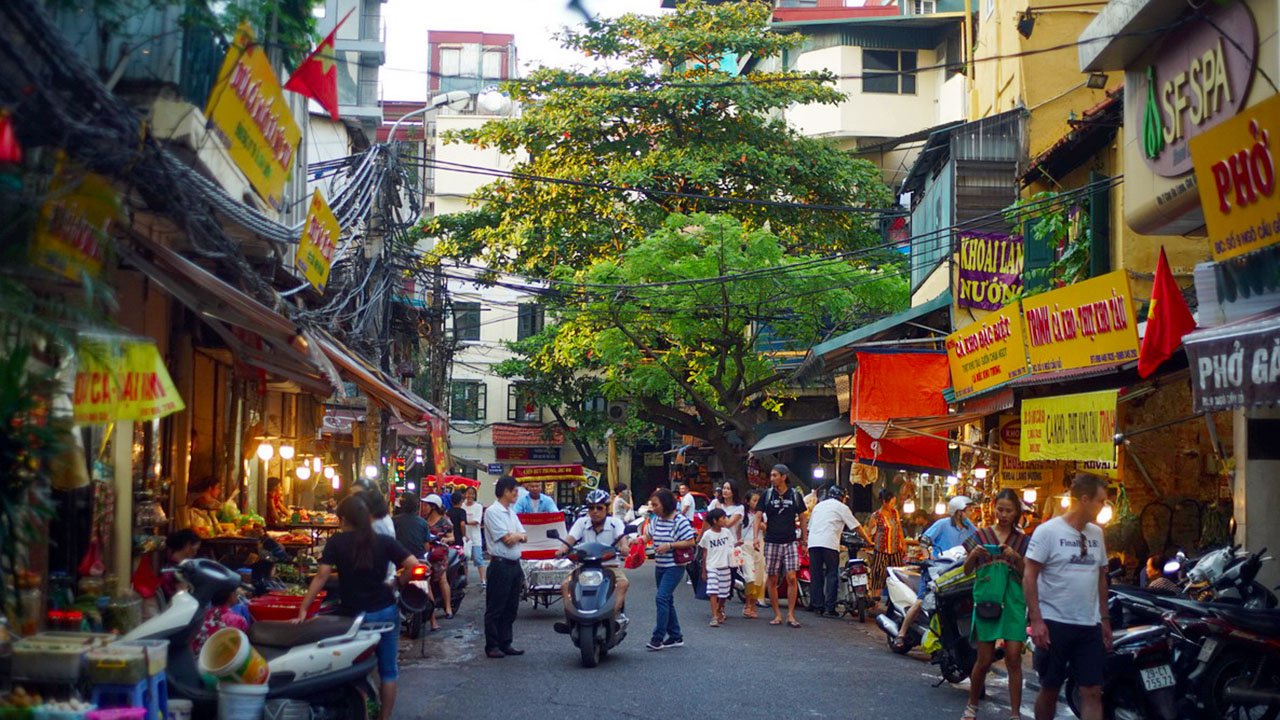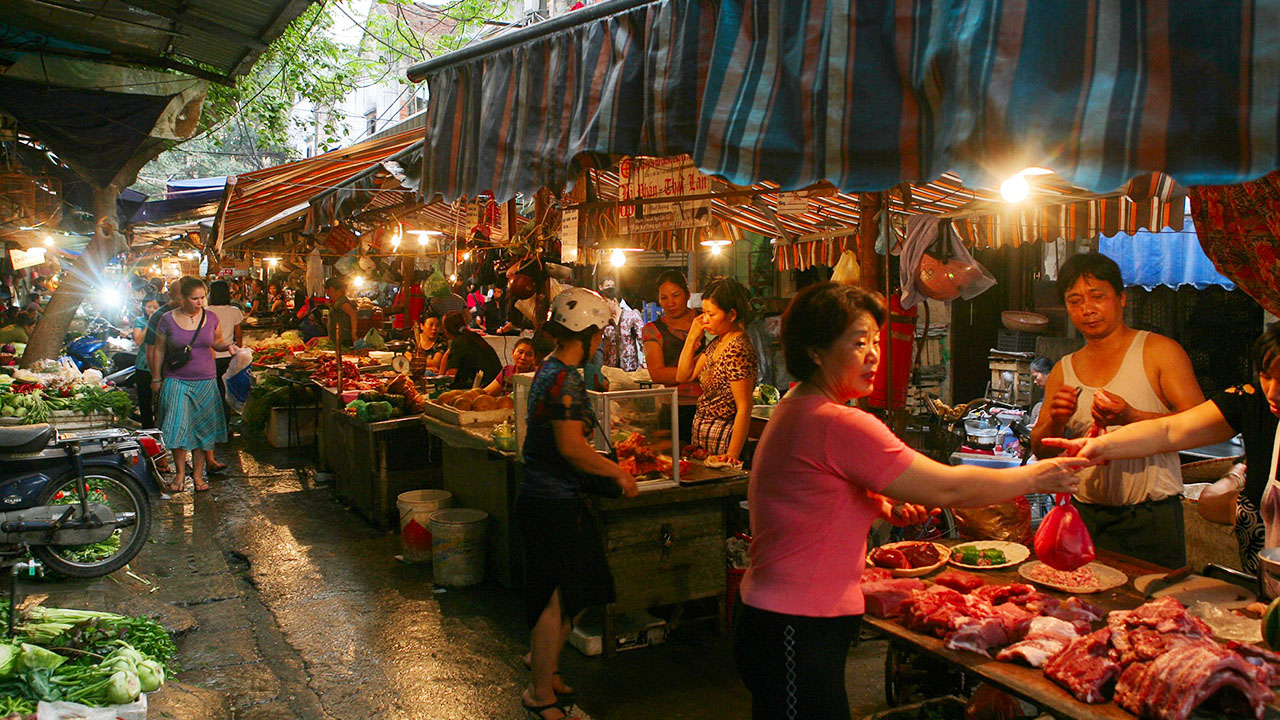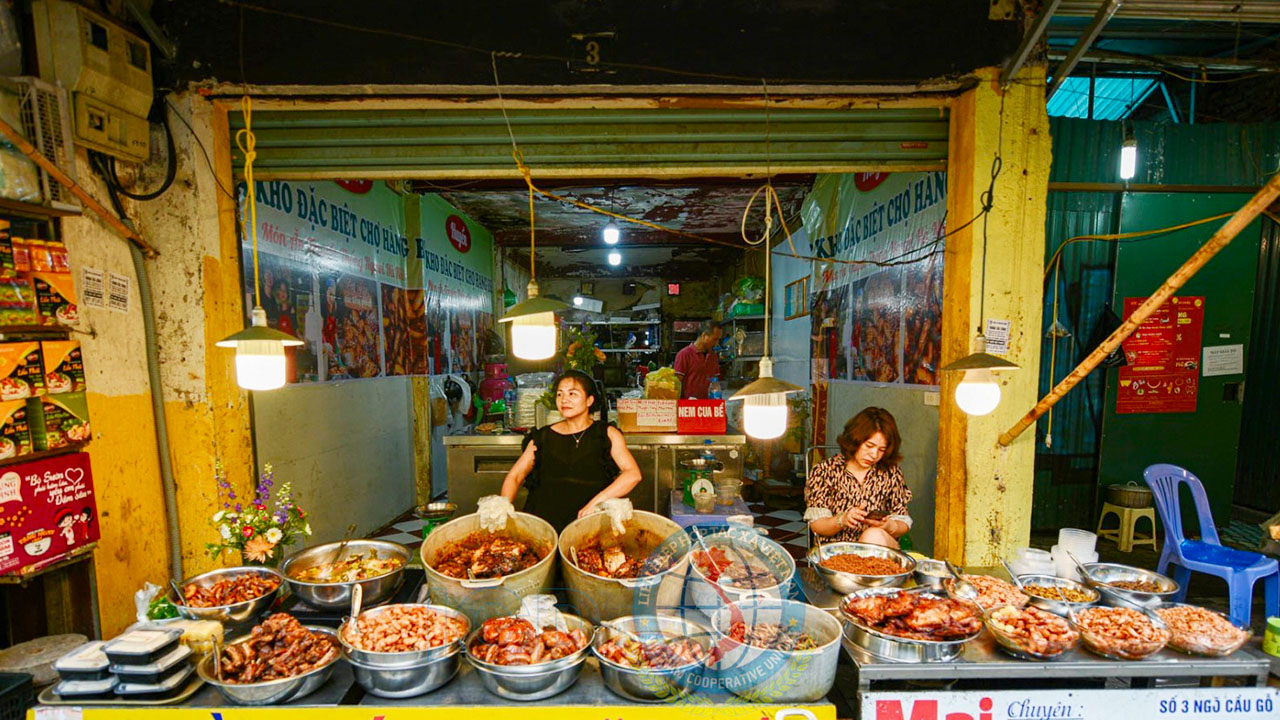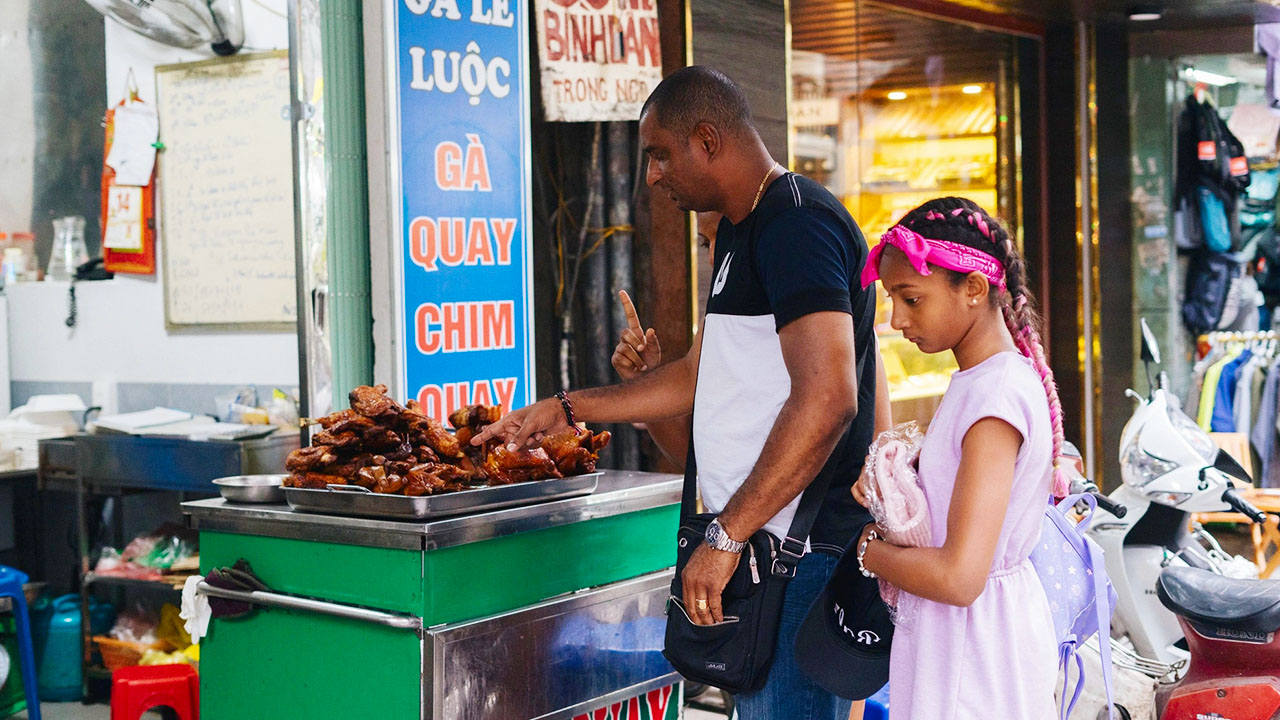Hang Be Market in Hanoi is a paradise for those who love to eat their way through new cultures. Indulge in an abundance of street food options, from steaming bowls of pho to crispy banh mi sandwiches. Sample exotic fruits, aromatic spices, and freshly caught seafood as you explore the diverse culinary offerings of this bustling market.
Introduction

Overview of Hang Be Market Hanoi
Nestled within the charming tapestry of Hanoi’s Old Quarter, just a brief five-minute stroll from the tranquil Hoan Kiem Lake, Hang Be Market commands a storied history spanning hundreds of years. Initially, it began as a humble trading hub for ‘be’—a traditional form of transportation fashioned from bamboo or wood. Over the centuries, this bustling market evolved, transitioning from a narrow focus on transportation to a broad spectrum of goods, particularly focusing on the culinary.
Present-day Hang Be Market is celebrated widely for its exceptional array of “ready-to-eat” food offerings. Traditional Vietnamese dishes like spring rolls, stewed fish, and caramelized pork and eggs tantalize visitors’ palates, drawing both locals and tourists alike. The market’s finely curated selection of high-quality ingredients, some of which are not easily found elsewhere in the city, makes it a preferred shopping destination despite its relatively higher prices. This reputation for premium goods has even earned it the nickname “market for the rich.”
Historical Significance
The historical significance of Hang Be Market cannot be overstated. It stands as a testament to Hanoi’s rich cultural heritage and historical trajectory. As one of the oldest markets in the area, its legacy intertwines with the evolution of Hanoi’s urban landscape.
From its origins as a center for trading primitive transportation, situated strategically near the Red River, Hang Be Market played a pivotal role in facilitating commerce. Its location enabled the smooth movement of goods and people, anchoring it firmly within the historical narrative of the city. As Hanoi developed, so did the market, transitioning into a central hub for food and produce.
Through the epochs, Hang Be Market has borne witness to Hanoi’s transformation while steadfastly anchoring the community to its roots. Today, it offers a window into the past, preserving the traditions and daily rhythms that have characterized Hanoian life for centuries.
Importance to Local Community
Hang Be Market symbolizes more than just a place of commerce; it epitomizes a focal point of communal life and cultural preservation. For the local community, the market serves multiple purposes beyond economic transactions. It operates as a vibrant social gathering spot, a place where stories are shared, traditions are passed down, and community bonds are strengthened.
Every day, vendors meticulously display their wares, echoing the enduring hustle and camaraderie that encapsulate the market’s spirit. It is a place where the relentless pace of modern life slows down just enough to allow the cultural and social fabric of the community to thrive.
Market Structure and Layout

Sections and Zones
Despite the myriad challenges posed by urban development and gentrification, Hang Be Market has been resiliently preserved and maintained by the local residents. Today, it primarily sprawls across several key streets: Hang Be, Gia Ngu, Cau Go, and Trung Yen. With approximately 20 dedicated food stalls, the market is a bustling maze of activity.
The market is tactically divided into distinct sections, each corner catering to specific needs:
- Ornamental Fish and Bonsai Plants: Along the main roads, visitors are greeted by a vibrant display of ornately decorated fish tanks and meticulously pruned bonsai plants. This section reflects the locals’ appreciation for aesthetics and tranquility.
- Flowers: This colorful section is reminiscent of festivals, a visual feast where myriad flowers blossom in full splendor, offering blooms that symbolize joy, celebration, and tradition.
- Breeding Animals: The bustling area dedicated to livestock such as pigs, chickens, and ducks infuses the market with an energetic, rustic charm, harkening back to Hanoi’s agrarian roots.
Key Vendors and Products
Situated strategically in Hanoi’s heart, Hang Be Market extends across several interconnected streets, mirroring its organic growth over centuries. Vendors from different backgrounds converge to offer a diverse tapestry of products.
Some key highlights include:
- Fresh Produce: Vendors offer a rich variety of seasonal fruits and vegetables, many of which are sourced directly from nearby farms, ensuring freshness and quality.
- Meats and Seafood: Fresh cuts of meat and an impressive selection of seafood highlight the market’s offerings, showcasing the meticulous care taken by vendors in sourcing the best.
- Ready-to-Eat Dishes: One of the market’s most popular sections, this area tantalizes with an array of traditional dishes, allowing visitors to sample the rich culinary heritage of Vietnam.
Architectural Features
The architectural layout of Hang Be Market is unique in its decentralized, open-air setup. Rather than existing in a single, confined structure, the market spills out onto the streets, merging seamlessly with the urban landscape.
The stalls are informally arranged along the sidewalks, with each vendor setting up shop in a space that has likely been used by generations before them. This iterative design maintains a vibrant, lively atmosphere, where the market organically adapts to the community’s shifting needs.
This permeability between market and city allows for an immersive and interactive experience. The open-air setup ensures that the market’s sights, sounds, and aromas extend beyond its bounds, inviting not just commerce but community interaction and cultural exchange.
Products and Services

Fresh Produce and Groceries
Hang Be Market is nothing short of a cornucopia of fresh produce and groceries, making it an essential destination for anyone keen on experiencing the authentic flavors of Hanoi. The market boasts a plethora of:
- Seasonal Fruits: Mangoes, lychees, dragon fruits, and pomelos.
- Vegetables: Fresh herbs like coriander and basil, root vegetables, leafy greens, and exotic items like bamboo shoots.
Vietnam being a major importer of U.S. processed foods—totaling $510 million in 2020—has influenced the high-quality standards maintained here. Local vendors emphasize Viet GAP (Vietnam Good Agricultural Practices) and Global GAP standards, ensuring that the produce is not only fresh but also safe for consumption.
Seafood and Meat
Vietnam’s affinity for fresh seafood and meat is palpably evident in Hang Be Market. Richly stocked and meticulously curated, this section of the market offers:
- Seafood: An array of fish caught from the Red River and surrounding waters, crabs, shrimp, and clams.
- Meats: Pork, beef, and poultry, cut fresh and sold with a focus on quality and sustainability.
American companies like Cargill, which has operated in Vietnam since 1995, have played an important role in providing animal nutrition services and grains, ensuring the quality and variety of meats available in the market.
Clothing and Accessories
Hanoi is renowned for its silk products, and Hang Be Market is no exception. Visitors can find:
- Silk Scarves and Ties: Available in various designs and colors, ideal for gifts or personal use.
- Clothing: Traditional Vietnamese attire like Ao Dai, alongside modern pieces crafted from silk and other fabrics.
Traditional Crafts and Souvenirs
Hang Be Market offers a treasure trove of traditional crafts and souvenirs:
- Cheo Masks: Intricately painted bamboo masks, embodying the traditional Vietnamese Cheo performances.
- Propaganda Posters: Vintage posters capturing Vietnam’s historical moments.
- Embroidered Tablecloths: Showcasing detailed mosaic-style patterns.
- Wooden Stamps: Customizable designs engraved on wooden blocks.
Food Stalls and Restaurants
A highlight of any visit to Hang Be Market is the gastronomic journey through its food stalls. These stalls serve an array of ready-made dishes:
- Spring Rolls: Both fresh and fried varieties.
- Stewed Fish and Caramelized Pork and Eggs: Traditional Vietnamese dishes that have stood the test of time.
- Hot Pot: Various types of hot pots catering to different tastes.
Cultural Significance

Role in Daily Life
Hang Be Market is more than a commercial hub; it’s a vibrant community space intrinsic to the daily life of Hanoians. The market serves as a rendezvous for families and friends, a place where culinary traditions meet daily necessities. For many, it’s a ritualistic part of life—visiting the market each day forms a cherished routine, filled with rich sights, intoxicating smells, and an abundance of sensory experiences.
Traditional Practices and Customs
Traditional practices and customs play an essential role in Hang Be Market’s identity. From the art of haggling—which is conducted with a unique mix of sharp wit and respectful negotiation—to the vendors’ meticulous preparation of keepsake recipes, every aspect of the market is steeped in cultural heritage.
Ancestor worship remains a prevalent practice, echoing the importance of family lineage and guiding spiritual practices. Crafts like silk painting and lacquerware line the stalls, reflecting the creativity and historical craftsmanship fiercely preserved by artisans.
Festivals and Events
Hang Be Market comes alive during festivals and cultural events, most notably the Lunar New Year (Tet). During these times, the market is a kaleidoscope of colors, with vendors selling festive foods and ornamental items that hold profound cultural significance. Lanterns, flowers, and special Tet dishes create an effervescent atmosphere, bridging the past with the present and bringing the community together in celebration.
Economic Impact

Employment and Livelihoods
Hang Be Market is a crucial provider of employment, integral to the livelihoods of numerous individuals. From vendors to transport service providers and beyond, a ripple effect of job opportunities emanates from the market. As per recent data, the broader travel and tourism sector in Vietnam is forecasted to support 5.96 million jobs by 2024, reflecting a significant growth trajectory.
Tourism and Revenue Generation
Tourism, a vital economic driver, injects considerable revenue into Hanoi’s economy, and Hang Be Market plays a crucial role in this ecosystem. With direct contributions to GDP, tourism-related activities around the market amplify economic growth. Visitors are drawn not only to the market’s rich offerings but also to the compelling cultural experience it provides, creating a robust tourism circuit that benefits local economies extensively.
Role in Local Economy
The influence of Hang Be Market on the local economy transcends mere commerce. It encapsulates traditional economic practices while simultaneously adapting to modern growth drivers. The market’s role as a platform for small-scale vendors and local producers positions it as a linchpin in Hanoi’s economic and social structure.
Challenges and Opportunities

Competition from Modern Supermarkets
In an increasingly modern and urbanizing Hanoi, competition from modern supermarkets presents both challenges and opportunities for Hang Be Market:
- Challenges: As young, urban, and affluent shoppers gravitate towards the convenience of supermarkets, traditional markets face pressures to evolve. Rising real estate costs and a fragmented supplier base add to these challenges.
- Opportunities: Cater to the niche market of consumers who value fresh, locally-sourced products. By leveraging their unique cultural and traditional array, markets like Hang Be can offer a shopping experience that complements supermarkets.
| Features | Hang Be Market | Modern Supermarkets |
|---|---|---|
| Atmosphere | Open-air, vibrant, traditional | Enclosed, modern, sterile |
| Product Variety | Locally sourced, unique items | Mass-market, varied but conventional |
| Consumer Experience | Interactive, culturally immersive | Convenient, fast-paced |
| Price | Slightly higher due to quality | Often competitive and varied |
| Sustainability | Eco-friendly, less packaging | Mixed, often higher use of packaging |
Sustainability and Environmental Concerns
Hanoi and, by extension, Hang Be Market face significant environmental challenges. Climate change impacts and urban modernization pose potential threats to the traditional market structure and supply chains. However, opportunities lie in embracing sustainable practices and promoting eco-friendly solutions, aligning with initiatives like Vietnam’s National Green Growth Strategy.
Modernization and Development
Balancing modernization and cultural preservation is a perennial challenge and opportunity for Hang Be Market. Sustainable and resilient development, driven by careful policy and community engagement, can ensure the market remains a vital part of Hanoi’s urban fabric.
Conclusion
Summary of Hang Be Market’s Importance
Hang Be Market holds a unique and irreplaceable position in Hanoi’s cultural and economic landscape. It is more than a marketplace; it is a repository of cultural heritage, a social hub, and a significant economic player.
Future Prospects and Potential
While challenges lie ahead, there are also immense opportunities. By modernizing sustainably, enhancing product quality, and curating a unique experience, Hang Be Market can continue to thrive amidst Hanoi’s evolving urban landscape.
Call to Action for Preservation and Support
Preserving the heritage and supporting the sustainable development of Hang Be Market is imperative. Whether through active community involvement, policy support, or even global awareness, the collective effort to maintain this vibrant cultural hub will ensure its continuity for future generations.
In closing, the rich tapestry of Hang Be Market is woven with threads of history, culture, and community. It is essential that its legacy be preserved and nurtured, allowing it to remain a cornerstone of Hanoi’s heritage and a beacon of tradition amidst modernization.


